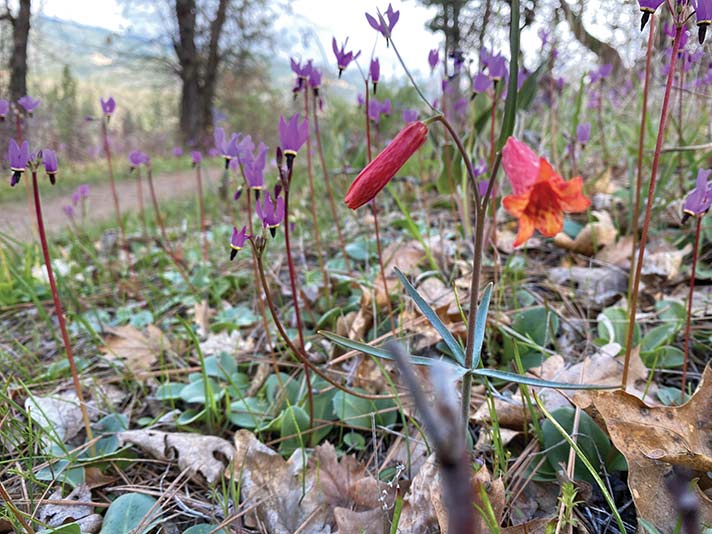Jacksonville Review – Dec 2023/Jan 2024
A lot has been happening in the past year in regard to hazardous fuels management in the Jacksonville Woodlands, Forest Park, and within and surrounding the City of Jacksonville. The Jacksonville Woodlands Association (JWA), the City of Jacksonville, Jacksonville Fire Department, Southern Oregon Land Conservancy, Rogue Forest Partners, Grayback Forestry, Civil West Engineering, Wildfire Mitigation Network, and Lomakatsi Restoration Project have been working together to plan and implement various projects to reduce the threat of high-intensity wildfire within and around the City of Jacksonville. Various grants have been obtained to fund this work from City, State, and Federal sources.
Many private landowners within and surrounding Jacksonville took advantage of the Jacksonville Community Wildfire Protection Project managed by Lomakatsi Restoration Project. Significant work in thinning, pruning, and hand piling the slash occurred earlier in the year before being shut down due to fire danger. Planning for continued work in the private lands and extending into the Britt, Beebe, and Beekman Woodland areas has occurred and work is starting up again now that we are in wetter weather. Expect to see thinning of Douglas-fir and other trees, pruning up to 8 feet, and piles of slash with covering throughout the treatment areas, many of which will be along some of the most popular trails in the Woodlands.
The City was granted funding from the State Fire Marshal to install a significant fuel break along the eastern ridges in Forest Park. This fuel break is meant to increase the probability of control of a wildfire moving toward or from Forest Park. Significant thinning of extremely thick brushlands is the centerpiece of this work and will reduce the potential for crown fire within the treatment footprint. Grayback Forestry has been contracted by the City to complete the work. Civil West Engineering is managing the contract for the City. Expect to see much of the manzanita and ceanothus brush species cut, thinning of ponderosa pine and Douglas-fir, pruning on the leave trees, and a significant number of hand piles across the treated areas. Once again, many of the treatment areas are along popular trails.
All of the hand piles generated by these hazardous fuels treatments will need to be burned in the near future to remove them from the landscape. Once a pile has cured through a dry season, it is available to burn once weather conditions are favorable for the burning. The smoke generated by burning becomes the biggest challenge to finding the burn window.
Oregon Department of Forestry (ODF) is responsible for issuing the permit to burn. ODF has staff meteorologists that Grayback and Lomakatsi will be working with to find the best burn window to reduce smoke impacts to populated areas. A typical burn day would look like a rainy, somewhat windy, unstable day that allows the smoke to mix vertically in the atmosphere and be transported away from populated areas via the upper level winds. Expect to see black circles on the ground where the piles were and some leaf scorch on the leave vegetation surrounding the burned pile. Within a few years the burned areas will recover and it will be more difficult to see the signs of the treatment that occurred.
Speaking of burning, the City and JWA have been working to complete a broadcast underburn within a portion of the Britt Woodlands. The original planned acreage of the burn was 7 acres. At a recent City Council meeting, Lomakatsi, Grayback, and JWA presented a proposal to increase the size of the burn to about 40 acres. The Council approved the request unanimously.
That was the easy part, however, implementing the underburn is extremely challenging due to several factors. A rare plant, Gentner’s fritillary (Fritillaria gentneri), is present throughout the woodlands which excludes the spring season for burning. In addition, due to the proximity to the greater Medford area and fire season, smoke clearance is very challenging to get in the late summer, early fall when the burn needs to occur. Also, if we wait too late in the fall, rains will cause green-up in the grasses and moisture will be retained in the fallen oak leaves resulting in a burn that would be too cool to meet the objectives for the underburn. Both this fall and last fall, attempts were made to get a burn permit from ODF, however, the weather conditions for smoke to mix vertically in the atmosphere were not favorable. We will continue to work to implement this burn and will be looking to complete it prior to the end of fire season for the best result.
Last but not least, JWA and the City partnered with the Wildfire Mitigation Network to develop a long-term fuels management plan for the Jacksonville Woodlands. The plan was completed over the summer and will help guide the JWA board in developing annual action plans for vegetation management within the Woodlands. Annual action plans are shared with Southern Oregon Land Conservancy, who holds and manages the conservation easements on the Woodlands.
A very busy year! We are very fortunate to have such a great group of partners to work with to help improve the wildfire resiliency of Jacksonville, the Woodlands and Forest Park! Keep hiking, running, and biking and enjoying the great trails and wild spaces we have available to us!
Please note: the Jacksonville Review is posting trail closure updates on its website and Facebook page.
Chris Johnson is a JWA Board Member.
